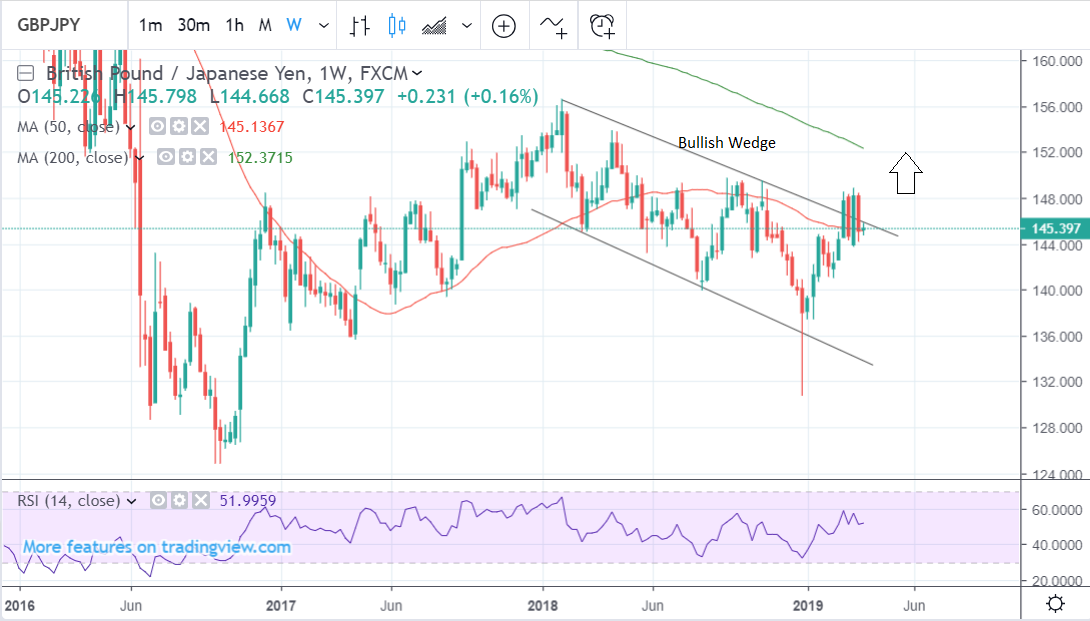Pound-to-Yen Rate Eyes Breakout from Wedge Pattern, as Falling Brexiteer Dominoes Boost Sterling

Image © Leonid Andronov, Adobe Stock
- GBP/JPY eyes break from top of wedge pattern.
- But 148.87 March 14 high must first be overcome.
- Brexit news driver for Pound; Risk trends for the Yen.
The Pound-to-Yen rate rate was trading around 146.17 Tuesday after rising strongly during the morning session, although studies of the charts suggest the exchange rate could rise further over the coming days.
Sterling advanced Tuesday after Jacob Rees-Mogg, head of the influential European Research Group of MPs, said recent events mean it won't be long before the only choice available to Brexiteers is between PM May's contentious and twice rejected EU Withdrawal Agreement, and no Brexit at all.
Markets have taken the comments to mean that he is close to supporting the EU Withdrawal Agreement on the next asking, although the Democratic Unionist Party (DUP) is still thought to be opposed to the Treaty.
The Pound-to-Yen rate has moved in volatile swings of late, flirting with the idea of a break from the top of a wedge pattern on the charts. From a technical perspective, the outlook favours more gains but only on the condition that the 148.87 March 14 highs are succesfully broken.

Above: Pound-to-Yen rate shown at weekly intervals.
More broadly the pair continues to push up against the top of a long bullish wedge pattern, suggesting the potential for a breakout and continuation higher. A break out from a large wedge like the one on GBP/JPY is likely to lead a strong rally.
But such a bullish extension would only come from a break above the 148.87 highs, with a subsequent target at the 152.50 level, which is also where the 200-week moving average (MA) sits.
The bullish overall outlook comes with some significant provisos. A bearish Japanese candlestick pattern called a ‘stick sandwich’ has formed on the weekly chart at the recent highs. This is composed of a long down week that is sandwiched between two long up weeks.
The pattern is a bearish reversal signal that has been enhanced by the fact that it was followed by a week of losses. A double top reversal pattern has also formed on the daily chart and if the exchange rate closes below the neckline at 143.720 it could result in a sudden, steep decline for the pair, likely down to the 140.0 area.
Above: Pound-to-Euro rate shown at daily intervals.
AA
The Japanese Yen: What to Watch
The Yen was the best performing G10 currency last week after disappointing economic data from a number of major countries stoked concerns about the outlook for global growth and led to increased safe-haven flows toward the Yen.
This week the currency is once again likely be moved primarily by flows seeking safe harbour from global uncertainty. Any further signs the world economy is slowing are likely to result in further gains for the Yen.
The main geopolitical event this week is another session of trade talks between the U.S. and China on Thursday. Although it's a little early to expect a formal agreement to be reached, opening statements might give a flavour of the mood between the two countries and could impact on markets.
Eventually, a deal is expected by the end of April when President’s Xi Jingping and Donald Trump meet for an official signing ceremony.
The main economic release for the Yen in the week ahead is the leading Tokyo consumer price index, which is out a full month before the nationwide measure and thus will provide an early insight into the inflation picture for the month of March.
Inflation is still a long way from the Bank of Japan’s (BoJ) 2.0% target and is likely to remain so for a while to come, analysts say. This means the BOJ will have to keep interest rates negative and bond yields low for a while yet, which is a headwind for the Yen.
Retail sales figures for February are another major release for the Yen. Consensus is for sales to have risen 0.9% last month, although the actual number will not be released until 23:50 London time on Thursday.
AA
The Pound: What to Watch
The main event for the Pound in the week ahead will be the third parliamentary vote on the government’s EU Withdrawal Agreement, although an exact date is yet to be set.
If Parliamentarians support the bill the UK will leave the EU on May 22 under the Withdrawal Agreement. But if MPs reject it then there the government has said it will offer a series of "indicative votes" to MPs, giving Parliament an opportunity to express its desired course.
At that point there will still be a risk that the UK leaves the EU without a deal and the key date in focus will be April 12, although this could change the moment the EU agrees to a further extension, if and when it does.
If Parliament was succesful in foisting another referendum or a general on the electorate, another much longer extension is sure to be required, alongside participation in the EU parliamentary elections.
However, and alternatively, if Parliament was to back the idea of a customs union with the EU or some other model of post-Brexit relationship it's possible that no further extension would be required as the details of such a relationship would be thrashed out in the second stage of the negotiations.
But the government must notify the EU of the path it intends to take before April 12.
“Leaving on April 12 without a deal is now the default path, and while that will most probably be avoided at the end, the mere fact this massive risk still lurks in the background is likely enough to keep sterling under pressure for now,” says XM's Hadjikyriacos.
On the data front, the next key release for the Pound is the final estimate for final quarter GDP growth, due out at 09:30 on Friday. Consensus is for growth to be confirmed at 0.2% for the final quarter and 1.4% for 2018 as a whole.
Time to move your money? Get 3-5% more currency than your bank would offer by using the services of foreign exchange specialists at RationalFX. A specialist broker can deliver you an exchange rate closer to the real market rate, thereby saving you substantial quantities of currency. Find out more here. * Advertisement
